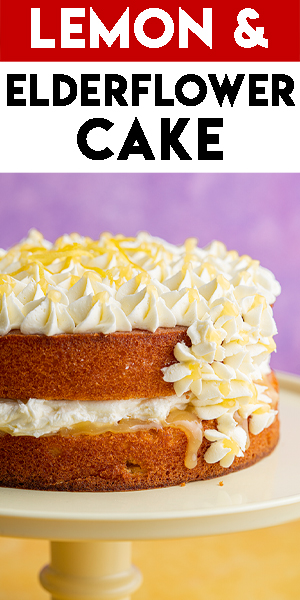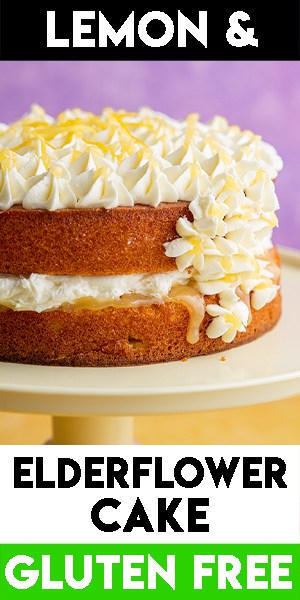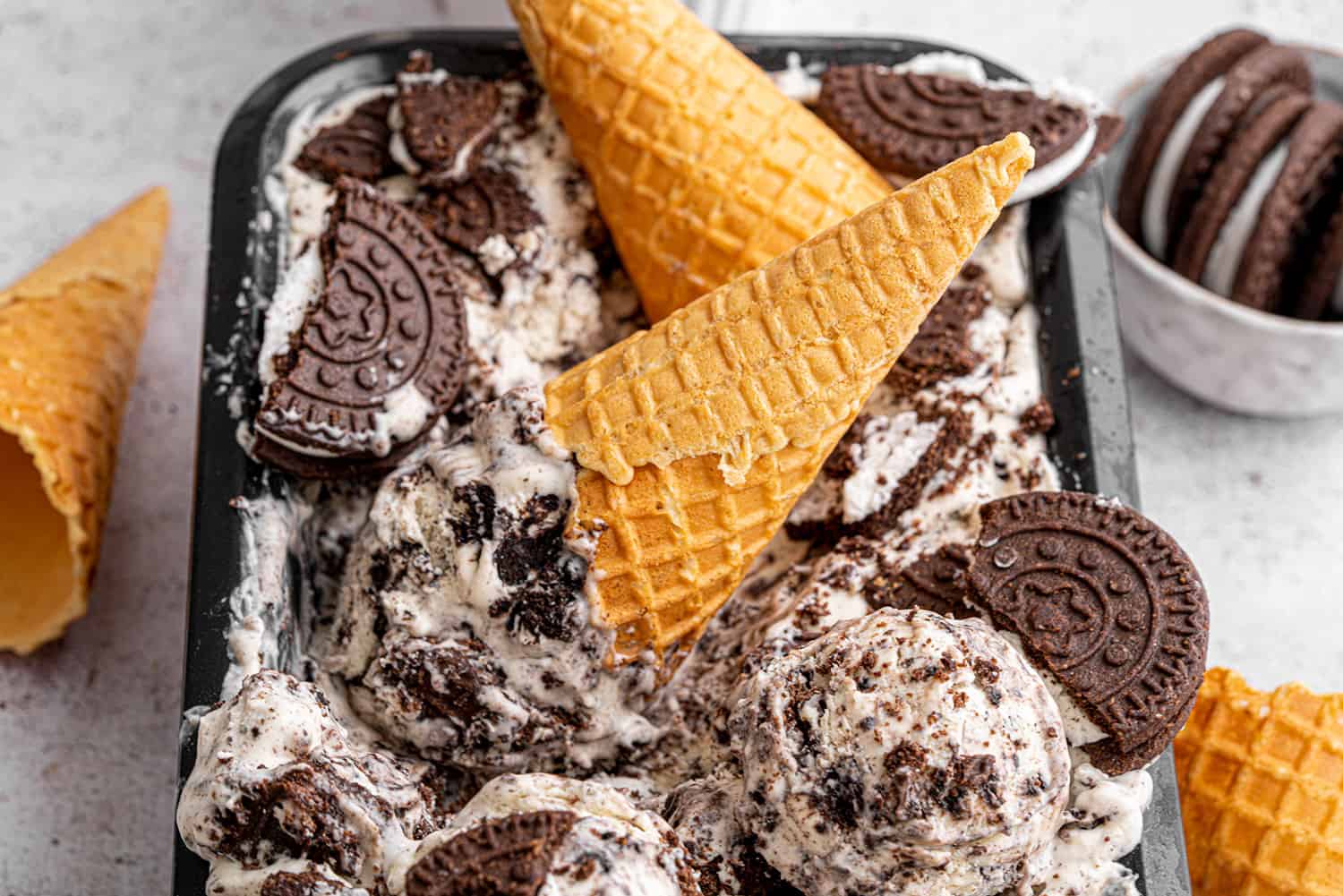Gluten-free lemon and elderflower cake recipe – the perfect flavour combination that’s sweet, zesty and delicate. Best of all, nobody would know it’s Coeliac-friendly and wheat-free!
Gluten-free lemon and elderflower cake recipe? This is basically a lemon and elderflower drizzle cake, topped with a creamy elderflower buttercream. Easy to make, but super decadent and easy on the eye!

Finally! I’ve found something with a floral-y flavour that I actually love ? Elderflower isn’t often big on my radar when it comes to baking, but this cake might change all of that for good…
And simply by remixing a classic gluten-free lemon cake, I’ve made something from another (very sunny and summery) world entirely.
Think sweet, sharp lemon, counterbalanced with a delicate, almost lychee-flavoured punch that’s both refreshing, yet creamy and indulgent. And yes, there’s elderflower in the sponge, the drizzle and the buttercream!
That’s a lot of depth from such a simple bake. And do I even need to keep saying it anymore? Nobody would ever know it’s gf!
Gluten-free lemon and elderflower cake recipe: What you’ll need…
- Butter – Butter is king in cakes and buttercream, but make sure yours is softened before beginning. Leaving it out of the fridge for a couple of hours should do it.
- Caster sugar: Of course, sugar isn’t just for sweetness – it helps to achieve a lovely crisp exterior and helps the cake to form a perfect crumb.
- Eggs: I used large eggs for this recipe, though medium eggs should be fine too.
- Lemons – You can’t beat fresh lemons when it comes to zest!
- Gluten-free self-raising flour: I use a simple commercial blend from the free from aisle in the supermarket. If you can’t find a blend like this where you live, you can always make your own using my gluten-free flour recipe.
- Gluten-free baking powder – Though there’s a little of this in gluten-free self-raising flour, a little goes a long way to ensure a nice, perfect rise. Adding too much has the opposite effect – you cake will sink in the middle!
- Xanthan gum: This helps to bind the cake crumb together so it doesn’t become crumbly, replacing the gluten that would otherwise do the same job.
- Elderflower cordial – Getting an instant elderflower flavour has never been easier. I simply used a bottle of this. I use it in the sponge, drizzle and buttercream.
- Icing sugar – You’ll need this for the buttercream as caster sugar won’t cut it whenever it comes to creating icing.
- Lemon curd (optional) – Either use store-bought or make your own using my recipe.
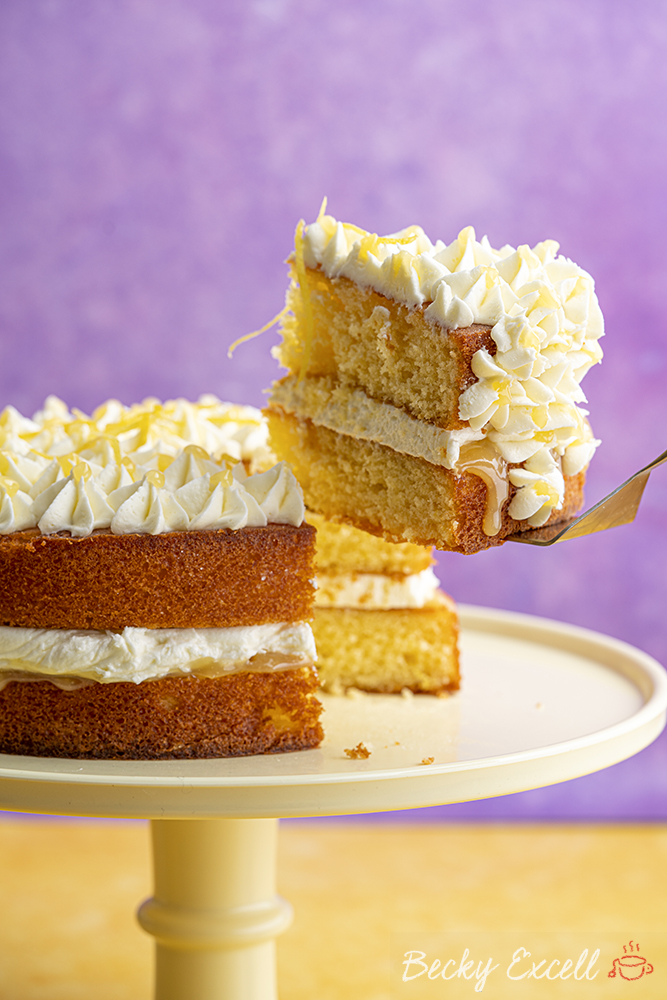
And best of all, the decorating is totally up to you.
For total ease and speed, skip piping icing on top/up the sides of the cake; just slap your buttercream in the middle of the cake and then again on top using a spatula. Job done!
To match how I’ve decorated the cake in the photos (I’m certainly not a professional cake decorator, so yes, you can definitely do this too), simply spread buttercream on one sponge and sandwich the other sponge on top.
Then, place the remaining buttercream into a piping bag fitted with an open star nozzle. Pipe as many ‘blobs’ as you can on top and up the side a little if you fancy. I then dolloped teeny-tiny dots of lemon curd on top of each blob (using another piping bag which I cut to leave a 4mm opening) because for some reason, I had a lot of patience that day.
It also made them look a little more like flowers!
How do I serve my gluten-free lemon and elderflower cake?
It’s totally up to you, but here’s a few ideas:
- With a good cuppa – Earl grey tea or even green tea are perfect pairings – flavour-wise.
- With a glass of Prosecco – Perfect for a little boozy celebration!
- As a part of gluten-free afternoon tea – This cake never fails to bring an extra level of fancy to the table.
Gluten-free lemon and elderflower cake recipe: Frequently Asked Questions
Can I make this recipe gluten-free? Is it suitable for Coeliacs?
It is gluten-free, though nobody would know just by tasting it – trust me!
Bear in mind that minimising cross-contamination is hugely important if you’re Coeliac or making this for someone who is. Here’s some tips from Coeliac UK on minimising the risk of cross contamination.
Also, make sure that all ingredients used don’t have any gluten-containing ingredients. Then make sure that they also don’t have a ‘may contain’ warning for gluten, wheat, rye, barley, oats (which aren’t gf), spelt and khorasan wheat (aka Kamut).
Here’s some more info from Coeliac UK on identifying safe gluten-free products.
Can I make you gluten-free lemon and elderflower cake recipe dairy-free?
Yes! Here’s the simple swaps you need to make:
- Use Stork hard margarine instead of butter.
- If using lemon curd, ensure it’s dairy-free.
Can I make you gluten-free lemon and elderflower cake recipe vegan?
Yep! If you follow the instructions above to make this recipe dairy free, then all you’ve got left to contend with is the eggs.
Here’s a few ideas you can use as egg replacements, so each of these = 1 egg.
- 3 tablespoons of aquafaba – water from a can of chickpeas. Make sure you whisk it up until frothy before adding.
- Egg replacement powder – I’d recommend using Orgran as it’s gluten free.
- 1 tablespoon of chia/flax seeds mixed with 2 tablespoons of water and left for 10 minutes in the fridge.
- 3 tablespoons of applesauce.
I haven’t tested all of these egg alternatives so let me know how you get on in the comments below.
Is this recipe low FODMAP?
For once, this recipe is actually low FODMAP and suitable for the elimination phase of the diet. No changes required!
Of course, ensure you check all your ingredients to ensure there’s no hidden high FODMAP ingredients hiding.

Which Elderflower cordial did you use?
Any should work fine but I used this one. You can find it with all the cordials in most supermarkets.
Can I make your gluten-free lemon and elderflower cake recipe using a stand mixer or electric whisk?
Of course you can, but you definitely don’t need to. I use both a stand mixer and an electric whisk for this recipe. Here’s a link to the electric whisk I use.
A stand mixer makes making buttercream a breeze (makes light work of longer periods of mixing) and an electric whisk speeds up mixing the cake batter (which is perfect for short blasts of mixing).
Whilst mixing the cake by hand is easy peasy, making the buttercream can take a little longer by hand. Just ensure you mix everything in thoroughly!
Do I need weighing scales to make your gluten-free lemon and elderflower cake recipe?
In short… yes, yes and yes! And I wouldn’t advise attempting any my recipes without them. One of the worst things you can do in any recipe is alter the quantities by mistake or on purpose.
(unless you know what you’re doing of course)
Why? Well, you’re sort of just gambling with the recipe and praying that it turns out ok, don’t you think? And I’ve generally already done the hard work there for you, so you don’t have to do the guesswork with measurements!
A lot of work went into fine tuning ratios and quantities so I wouldn’t mess around with them unless you really know your stuff. I’d recommending using digital cooking scales like these so you know you’re getting an accurate measurement and replicating my recipe as accurately as poss.
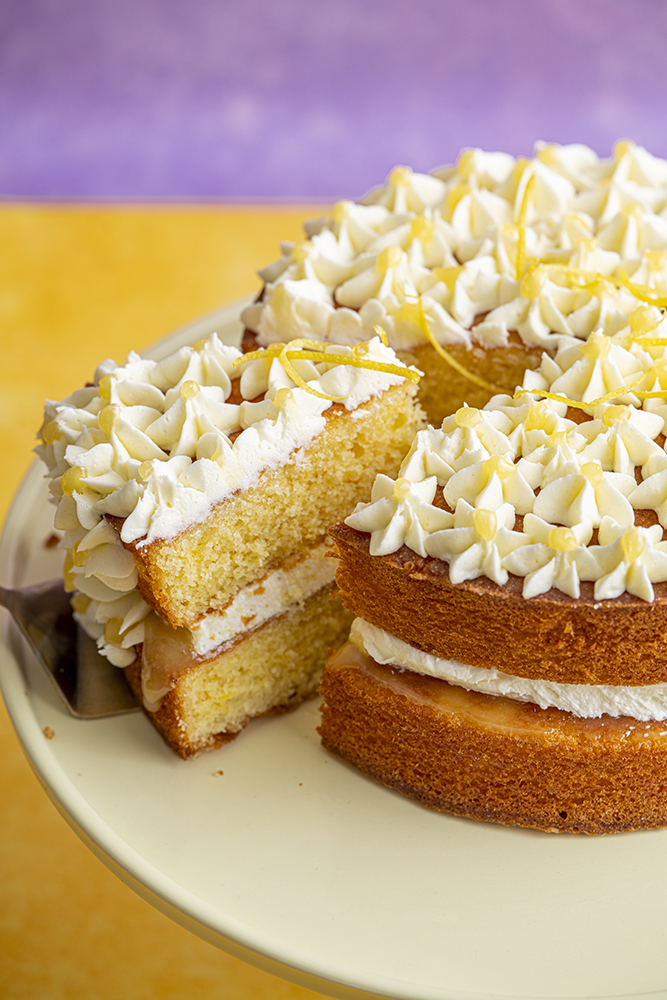
Gluten-free lemon and elderflower cake recipe: Tips for perfect bake every time
- If your sponge mixture splits, don’t panic! It should sort itself out once you add in the gluten-free self-raising flour. This happens due to the large amount of wet ingredients and doesn’t affect the end result whatsoever.
- Please don’t try to ice the cake whilst its still warm. Not surprisingly, buttercream contains butter, which yes, will melt!
- When splitting your cake mixture into two round baking tins, weigh both of them as you pour in the mixture. This will ensure both sponges are the perfect size.
- Using different size cake tins will affect bake time. I used two round 8in baking tins for this recipe – as a general rule of thumb, larger sized tins will mean it bakes quicker and smaller tins will mean it’ll need longer in the oven.
- Use a skewer or cake tester to check if your sponges are done in the middle. Just give it a poke in the middle – if it comes out clean, it’s done! If it comes out wet, then pop it back in for longer.

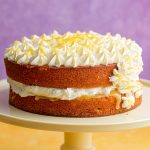
Gluten-free Lemon and Elderflower Cake Recipe
Ingredients
For the sponges
- 225 g butter softened (use Stork hard margarine if dairy-free)
- 225 g caster sugar
- 4 large eggs
- zest of 2 lemons
- 225 g gluten-free self-raising flour
- 1 tsp gluten-free baking powder
- 1/4 tsp xanthan gum
- 55 ml elderflower cordial
For the drizzle
- 80 g caster sugar
- 100 ml elderflower cordial
For the buttercream
- 200 g butter softened (use Stork hard margarine if dairy-free)
- 400 g icing sugar
- 60 ml elderflower cordial
Extras
- lemon curd optional – ensure dairy-free if necessary
Instructions
For the sponges:
- Prepare 2 circular cake tins (mine are 20cm) – grease them and cut a circle of parchment paper to sit in the bottom. Preheat your oven to 160C Fan / 180C.
- Cream together your softened butter and sugar until lighter in colour and fluffy.
- Add in your eggs one at a time mixing in between each briefly, followed by your lemon zest.
- Add in your flour, baking powder and xanthan gum and mix it in.
- Follow this with your elderflower cordial and mix it in.
- Divide the mixture between the two tins evenly.
- Bake for around 25-30 minutes (remember never to open the oven until you think they are definitely done). To check if the sponges are cooked, insert a skewer and if it comes out clean, it’s done!
- Whilst the cakes are in the oven mix together your drizzle ingredients in a small bowl. Once the cakes are baked gradually spoon the drizzle over the top of them and allow to cool in the tin.
For the buttercream:
- Place your butter in a stand mixer (or electric hand whisk if you don’t have a stand mixer), mix on its own on a high speed for about 5 minutes. The butter should change from a more yellow colour to being a lot more pale.
- Add your icing sugar gradually to the butter (I do this in two stages). I mix each addition of icing sugar for around 3 minutes before adding the second half.
- Add your cordial and mix again for a few more minutes.
To assemble:
- Carefully place one of your sponges onto your serving plate.
- Spread a thin layer of lemon curd on the base sponge and then a thicker layer of buttercream on your second sponge – sandwich them together.
- If you want to decorate like how I did, pop the rest of the buttercream into a piping bag with a small star nozzle and then pipe blobs all over the top (and slightly down the sides too if you fancy!) Add some extra lemon curd drops on top too. (you DON’T have to decorate like this – just spread a layer of the buttercream on top if you’d prefer, you might not need quite as much)
- Top with a little extra grated lemon zest and enjoy!
Nutrition
Thanks for reading all about my gluten-free lemon and elderflower cake recipe! If you make it, I’d love to see how it turned out so don’t forget to take a snap of your creations and tag me on Instagram!
Any questions about the recipe? Please do let me know by following me on Instagram and leaving me a comment on a recent photo!
Thanks for reading,
Becky xxx
Don’t forget to pin this for later!

